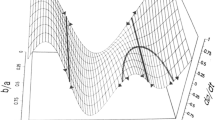Abstract
Van Gelder (1995) has recently spearheaded a movement to challenge the dominance of connectionist and classicist models in cognitive science. The dynamical conception of cognition is van Gelder's replacement for the computation bound paradigms provided by connectionism and classicism. He relies on the Watt governor to fulfill the role of a dynamicist Turing machine and claims that the Motivational Oscillatory Theory (MOT) provides a sound empirical basis for dynamicism. In other words, the Watt governor is to be the theoretical exemplar of the class of systems necessary for cognition and MOT is an empirical instantiation of that class. However, I shall argue that neither the Watt governor nor MOT successfully fulfill these prescribed roles. This failure, along with van Gelder's peculiar use of the concept of computation and his struggle with representationalism, prevent him from providing a convincing alternative to current cognitive theories.
Similar content being viewed by others
References
Brooks, R. (1991), ‘Intelligence without Representation’, Artificial Intelligence, 47, 139-159.
Busemeyer, Jerome R., and Townsend, James T. (1993), ‘Decision Field Theory: A Dynamic Cognitive Approach to Decision Making in an Uncertain Environment’, Psychological Review c, 432-459.
Churchland, P. S., and Sejnowski, T (1992), The Computational Brain, Cambridge, MA: MIT Press.
Churchland, Paul (1989), A Neurocomputational Perspective, Cambridge, MA: MIT Press.
Newell, A. (1990), Unified Theories of Cognition, Cambridge, MA: Harvard University Press.
Pollack, J. (1990), ‘Recursive Distributed Representations’, Artificial Intelligence, 46, 77-105.
Pouget, A. and Sejnowski, T. J. (1990), ‘Neural Models of Binocular Depth Perception’, Cold Spring Harbour Symposia on Quantitative Biology, Vol. 55, pp. 765-777.
Smolensky, Paul (1988). ‘On the Proper Treatment of Connectionism’, Behavioral and Brain Sciences, 11, 1-23.
Townsend, James T. (1992), ‘Don't be Fazed by PHASER: Beginning Exploration of a Cyclical Motivational System’, Behavior Research Methods, Instruments, & Computers, 24, 219-227.
van Gelder, T. (1995), ‘What Might Cognition Be, If not Computation?’, The Journal of Philosophy, xci, 345-381.
van Gelder, T. and Port, R. (1995), ‘It's About Time: An Overview of the Dynamical Approach to Cognition’, in R. Port, and T. van Gelder (Eds.), Mind as motion: Explorations in the Dynamics of Cognition, Cambridge, MA: MIT Press.
Author information
Authors and Affiliations
Rights and permissions
About this article
Cite this article
Eliasmith, C. Computation and Dynamical Models of Mind. Minds and Machines 7, 531–541 (1997). https://doi.org/10.1023/A:1008296514437
Issue Date:
DOI: https://doi.org/10.1023/A:1008296514437




